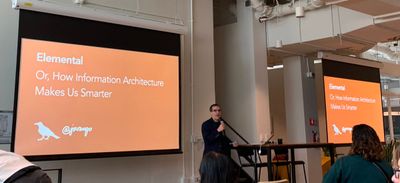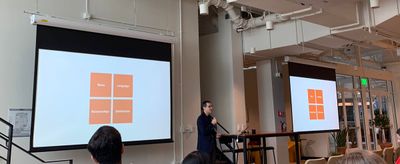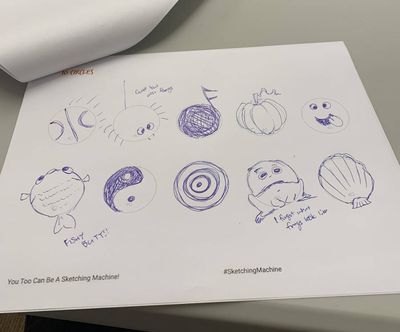World IA Day SF 2020 notes

Elemental: Or, how IA makes us smarter by Jorge Arango
Original thread on Twitter

Jorge points out the periodic table was designed by Dmitri Mendeleev. These substances did not arrange themselves magically! Listing known elements by atomic weight didn’t take into account all characteristics, nor unknown elements. It took a lot of iteration.
At first, ancient humans thought there were only 4 elements: earth, fire, air, and water. Developing it into the periodic table has been a process, and showed our gaps in knowledge. “The need to understand is deeply human.”
Language: An IA Element
“We set boundaries through words.” It sets our cultures, norms, and institutions. Language skills matter more than ever.
Jorge quotes Andrew Hinton about language being to humans like water is to fish. We are so immersed in it, we almost take it for granted. He suggests learning a second language to appreciate language once more.
The power of language is that it defines something in the world that we can discuss. But we have to remember that language is a reduction and abstraction. It is not the world. IAs have to try extra hard to see what is really there.
Distinction: An IA element
No distinctions are real, but we experience them through language. We have to be careful when talking about differences.
When you aren’t given an option to distinguish whether you hate something, you might choose something else to substitute. (why @jarango can’t trust “curious” reactions on LinkedIn anymore!)
People can latch to differences and distinctions, making it difficult to truly understand. Reality is never black and white.
Relationships: An IA element
By labeling distinctions, we create new relationships between them.
Jorge says information is anything that reduces uncertainty, and helps predict. The periodic table did that, because it explained elemental relationships and even predict elements that hadn’t been discovered yet.
But when creating new relationships, we can destroy the original meaning. The term “news feed” on Facebook has diluted the meaning of news re: journalism. Design skirts being Orwellian if we aren’t careful.
Rules: An IA element
We have to explain why certain configurations exist. There has to be a method to the madness. That allows us to be more certain of our predictions.
The roads show you where you can drive. The links on a webpage show you what you can click on. That’s a lot of power. All taxonomies are political. “IAs have to have their values straight, and we have to be politically savvy.”
IAs must design the systems that produce and manage structures, not just the structures themselves. “We’re not designing walls, but the trellis on which other things will grow.” It’s not just governance, it’s stewardship.

Jorge points out that Mendeleev was not an IA, he was a chemist. IA is everywhere. We all have to do IA now, to help make sense of the world.
My talk about using IA in writing the cannabis business permit application

I was a bit 😱 I would be the sole speaker after Jorge, but our talks actually worked out well! Jorge’s was high level and inspiring (which I love about many talks at The IA Conference) and mine was “ok here’s how you actually make it work!” 😄 Both types are valuable!
Read the transcript, although the super TL;DR takeaways:
- IA tools and principles can help convert policies into something usable for the public
- IA principles can be used for deliverables outside of sitemaps and wireframes, like content design
- Where there’s any information at all, there IA is
Rizwan Javaid’s workshop on sketching

